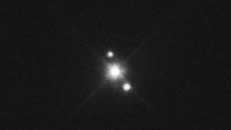
About the Planets
The solar system has eight planets: Mercury, Venus, Earth, Mars, Jupiter, Saturn, Uranus, and Neptune. There are five officially recognized dwarf planets in our solar system: Ceres, Pluto, Haumea, Makemake, and Eris.
Planets
Dwarf Planets
The solar system has eight planets: Mercury, Venus, Earth, Mars, Jupiter, Saturn, Uranus, and Neptune. There are five officially recognized dwarf planets in our solar system: Ceres, Pluto, Haumea, Makemake, and Eris.
Inner Planets
The first four planets from the Sun are Mercury, Venus, Earth, and Mars. These inner planets also are known as terrestrial planets because they have solid surfaces.

Mercury Facts
Mercury is the planet nearest to the Sun, and the smallest planet in our solar system.


Earth Facts
Earth – our home planet – is the third planet from the Sun, and the fifth largest planet.

Outer Planets
The giant planets in the outer solar system don't have hard surfaces. Instead, they have swirling gases above a core. Jupiter and Saturn are gas giants. Uranus and Neptune are ice giants.

Jupiter Facts
Jupiter is the fifth planet from the Sun, and the largest planet in our solar system.

Saturn Facts
Saturn is the sixth planet from the Sun, the second largest planet in our solar system.

Uranus Facts
Uranus is the seventh planet from the Sun, and the third largest planet in our solar system.

Neptune Facts
Neptune is the eighth and most distant planet in our solar system. It's the fourth largest planet.
Dwarf Planets
Dwarf planets include longtime favorite Pluto, Ceres, Makemake, Haumea, and Eris. Ceres is the only dwarf planet in the inner solar system. It's in the main asteroid belt between Mars and Jupiter.

Ceres Facts
Dwarf planet Ceres is the largest object in the asteroid belt between Mars and Jupiter, and it's the only dwarf planet in the inner solar system.

Pluto Facts
Pluto was long considered our solar system's ninth planet. It was reclassified as a dwarf planet in 2006 by the International Astronomical Union.

Haumea Facts
Haumea was nicknamed Santa by one discovery team. It is oval-shaped, and is one of the fastest rotating large objects in our solar system.

Makemake Facts
Makemake is slightly smaller than Pluto, and is the second-brightest object in the Kuiper Belt, while Pluto is the brightest.

Eris Facts
The discovery of Eris helped trigger the debate in the scientific community that led to the decision to clarify the definition of a planet.
Planet Sizes and Locations in Our Solar System
Our solar system has eight planets, and five officially recognized dwarf planets. Which planet is biggest? Which is smallest? What…
Read the Story
Is There Another Planet in the Solar System?
It's an intriguing idea that might explain some current mysteries, but direct evidence of another planet has yet to be found.
Learn More
Temperatures Across Our Solar System
Let’s look at the mean temperature of the Sun, and the planets in our solar system.
Read the Story




